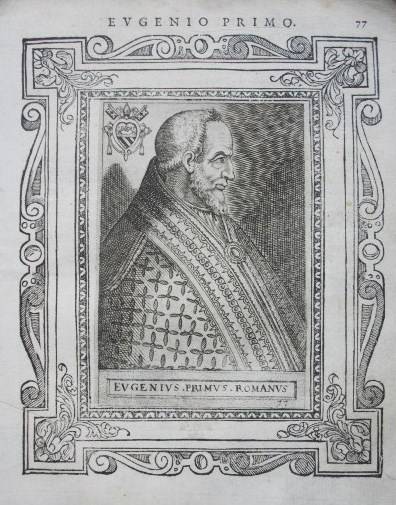Pope Saint Eugene I
Elected August 10, 654, and died at Rome, June 2, 657. Because he would not submit to Byzantine dictation in the matter of Monothelism, St. Martin I was forcibly carried off from Rome (June 18, 653) and kept in exile till his death (September, 655). What happened in Rome after his departure is not well known. For a time the Church was governed in the manner usual in those days during a vacancy of the Holy See, or during the absence of its occupant, viz., by the archpriest, the archdeacon, and the primicerius of the notaries. But after about a year and two months a successor was given to Martin in the person of Eugene (August 10, 654). He was a Roman of the first ecclesiastical region of the city, and was the son of Rufinianus. He had been a cleric from his earliest years, and is set down by his biographer as distinguished for his gentleness, sanctity, and generosity. With regard to the circumstances of his election, it can only be said that if he was forcibly placed on the Chair of Peter by the power of the emperor, in the hope that he would follow the imperial will, these calculations miscarried; and that, if he was elected against the will of the reigning pope in the first instance, Pope Martin subsequently acquiesced in his election (Ep. Martini xvii in P.L., LXXXVII).
One of the first acts of the new pope was to send legates to Constantinople with letters for the Emperor Constans II, informing him of his election, and presenting a profession of his faith. But the legates allowed themselves to be deceived, or gained over, and brought back a synodical letter from Peter, the new Patriarch of Constantinople (656-666), while the emperor’s envoy, who accompanied them, brought offerings for St. Peter, and a request from the emperor that the pope would enter into communion with the Patriarch of Constantinople. Peter’s letter proved to be written in the most obscure style, and avoided making any specific declaration as to the number of “wills or operations” in Christ. When its contents were communicated to the clergy and people in the church of St. Mary Major, they not only rejected the letter with indignation, but would not allow the pope to leave the basilica until he had promised that he would not on any account accept it (656).  So furious were the Byzantine officials at this contemptuous rejection of the wishes of their emperor and patriarch that they threatened, in their coarse phraseology, that when the state of politics allowed it, they would roast Eugene, and all the talkers at Rome along with him, as they had roasted Pope Martin I (Disp. inter S. Maxim. et Theod. in P.L., CXXIX, 654). Eugene was saved from the fate of his predecessor by the advance of the Moslems who took Rhodes in 654, and defeated Constans himself in the naval battle of Phoenix (655). It was almost certainly this pope who received the youthful St. Wilfrid on the occasion of his first visit to Rome (c. 654). He went thither because he was anxious to know “the ecclesiastical and monastic rites which were in use there”. At Rome he gained the affection of Archdeacon Boniface, a counsellor of the apostolic pope, who presented him to his master. Eugene “placed his blessed hand on the head of the youthful servant of God, prayed for him, and blessed him” (Bede, Hist. Eccles., V, 19; Eddius, In vit. Wilf., c. v). Nothing more is known of Eugene, except that he consecrated twenty-one bishops for different parts of the world, and that he was buried in St. Peter’s. In the Roman Martyrology he is reckoned among the saints of that day.
So furious were the Byzantine officials at this contemptuous rejection of the wishes of their emperor and patriarch that they threatened, in their coarse phraseology, that when the state of politics allowed it, they would roast Eugene, and all the talkers at Rome along with him, as they had roasted Pope Martin I (Disp. inter S. Maxim. et Theod. in P.L., CXXIX, 654). Eugene was saved from the fate of his predecessor by the advance of the Moslems who took Rhodes in 654, and defeated Constans himself in the naval battle of Phoenix (655). It was almost certainly this pope who received the youthful St. Wilfrid on the occasion of his first visit to Rome (c. 654). He went thither because he was anxious to know “the ecclesiastical and monastic rites which were in use there”. At Rome he gained the affection of Archdeacon Boniface, a counsellor of the apostolic pope, who presented him to his master. Eugene “placed his blessed hand on the head of the youthful servant of God, prayed for him, and blessed him” (Bede, Hist. Eccles., V, 19; Eddius, In vit. Wilf., c. v). Nothing more is known of Eugene, except that he consecrated twenty-one bishops for different parts of the world, and that he was buried in St. Peter’s. In the Roman Martyrology he is reckoned among the saints of that day.
James F. Loughlin (Catholic Encyclopedia)







